#avemetatarsalia
Text

#is it me or are the weird dogs getting bigger#he looks hungry#should i?#should i do it?#should I give him a French fry#french fries#weird#strange#weird horse#weird dog#there’s a weird horse in my yard#weird dog series#lacusovagus#chaoyangopterid#chaoyangopteridae#azhadarchid#azhdarchidae#azhdarchoid#azhdarchid#azhdarchoidea#crato formation#night#pterosaurs but now#pterosaur post#pterosaur#avemetatarsalia#paleontology#paleoart#art#cretaceous
701 notes
·
View notes
Text
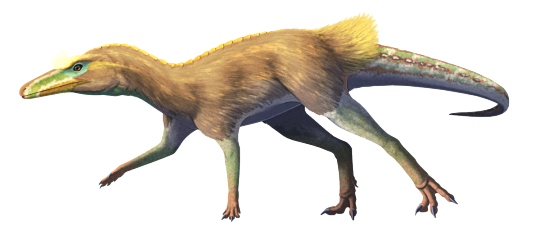
Last week I mentioned the one oddball dinosauriform that had crocodilian-like osteoderm armor, so let's take a look at that one too.
Lewisuchus admixtus lived in what is now northwest Argentina during the late Triassic, around 236-234 million years ago. About 1m long (3'3"), it was an early member of the silesaurids – a group of dinosauriforms that weren't quite dinosaurs themselves, but were very closely related to the earliest true dinosaurs.
(They've also been proposed as instead being early ornithisichians, but we're not getting into that today.)
Much like its later silesaurid relatives Lewisuchus had a long neck and slender limbs, and was probably mainly quadrupedal, possibly with the ability to briefly run bipedally to escape from threats. Its serrated teeth suggest it was carnivorous, likely feeding on both smaller vertebrates and the abundant insects found in the same fossil beds.
Uniquely for an early dinosauriform it also had a single row of bony osteoderms running along its spine. Although it lived at close to the same time as the similarly-armored Mambachiton their last common ancestor was at least 10 million years earlier, and no other early dinosaur precursors with osteoderms are currently known – so this was probably a case of Lewisuchus independently re-evolving the same sort of feature.
—
NixIllustration.com | Tumblr | Patreon
#science illustration#paleontology#paleoart#palaeoblr#lewisuchus#silesauridae#dinosauriformes#avemetatarsalia#archosaur#reptile#art#the early ornithischian idea is intriguing BUT it's also being pushed by the ornithoscelida gang#so that's a thing#(...i should probably also talk about the state of ornithoscelida at some point; it's been what almost seven years?)#(short version: we still dunno and early dinosaur relationships resolve in multiple equally-likely ways; More Data Is Needed)
522 notes
·
View notes
Note
Wait, pterosaurs aren't bipedal?
(I think i'm about to learn something)
Nope! Based on biomechanical modeling *and* footprint fossils, we know they were quadrupedal! They were also plantigrade, unlike dinosaurs (incl birds)! Yet another way dinosaurs are waaaaaay more birdie than pterosaurs.
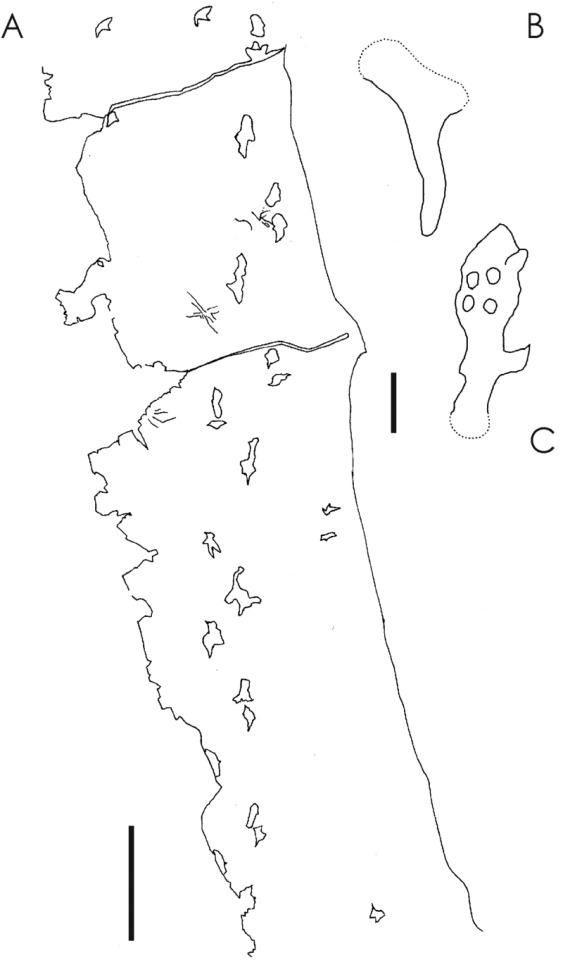
Azhdarchid Trace Fossil
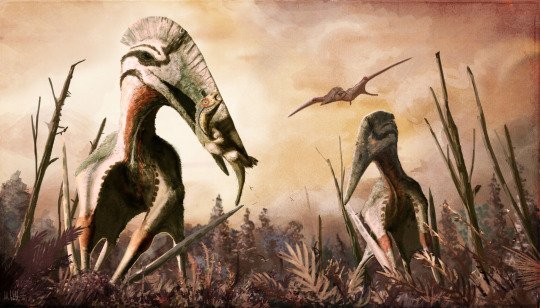
Azhdarchids, by Mark Witton, CC BY-SA 4.0
85 notes
·
View notes
Text
Teleocrater rhadinus

A large Teleocrater, an aphanosaur and close dinosaur and pterosaur relative, investigates a nearby cave in search of food, shelter, or both.
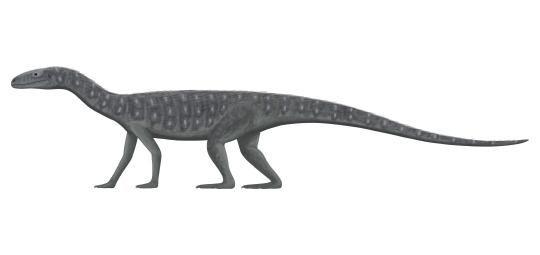
Despite their somewhat superficially lizard-like appearance, aphanosaurs were actually more closely related to birds than anything else alive today. As such, our fella here has some speculative fuzz that may or may not have been present. Although they do belong to the avemetatarsalia clade alongside the likes of dinosaurs and pterosaurs, aphanosaurs actually lacked the "bird metatarsal" condition in their ankles entirely, instead having the more traditional crurotarsal or "crocodile normal" ankles. So yes, the first "bird ankle animals" did not, in fact, have bird ankles at all. Real taxonomy moment there.
184 notes
·
View notes
Text
Day 10: Pterosaurs are Not Flying Dinosaurs
Today's competitors are close cousins to our dinosaur friends. Pterosaurs are often mistaken for dinosaurs because they cover the exact same time frame as them but they are in fact, a sister taxon. Both are branches of avemetatarsalia which just means fused ankles.
Pterosaurs lack a few dinosaur synapomorphies. Or distinguishing characteristics such as an open acetabulum (hip socket) and a deltopectoral crest on the humorus (muscle attachment point in dinosaurs).

Competitor 1: Pterodactylus

Competitor 2: Rhamphorynchus
REBLOG for RHAMPHORHYNCHUS
LIKE for PTERODACTYLUS
18 notes
·
View notes
Text
Why defining "birds" precisely is hard
(A reply to @lyxthen-reblogs that got too long and is now its own post)
A long time ago (in the 1700s), we didn't really have any idea of how birds came about - evolutionary theory itself would have to wait another century! And, we didn't have knowledge of extinct species either, or even of the fact extinction was a thing. Carl Linnaeus, when setting up the first taxonomical classification of life, grouped modern birds in the class Aves. Mammals were grouped in Mammalia, reptiles, amphibians and cartilaginous fish in Amphibia, bony fish in Pisces, arthropods in Insecta and all other animals in Vermes.
This first classification was pretty crude, and, around 1820, scientists like de Blainville and Latreille began distinguishing reptiles from "batrachians" as separate classes. De Blainville, pointing out similarities between reptiles and birds, labelled the former as "ornithoid" (bird-like) while amphibians were "ichthyoid" (fish-like). In 1825, Latreille fully separated amphibians (Batrachia, later Amphibia) from reptiles (Reptilia).
The first major turning point for taxonomy came in the next decades, as many fossils of now-extinct creatures were unearthed. In 1842, Richard Owen coined the term Dinosauria, then uniting the recently discovered Megalosaurus, Hylaeosaurus and Iguanodon.
But it wouldn't be until the 1860s that Darwinian evolution would highlight the flaws in the earlier understanding of separate classes. In 1863, Thomas Henry Huxley would suggest uniting birds and reptiles, creating the class Sauropsida the next year. Huxley was the first to suggest birds evolved from dinosaurs, comparing the recently-discovered Archaeopteryx (1861) with Compsognathus. As cladistics didn't exist back then, no attempt at precisely extending the definition of "bird" to extinct forms was made, even though Archaeopteryx was usually called "the first bird" (Urvogel).
Unfortunately, this hypothesis would be shelved for a whole century, leading to little progress happening in terms of understanding bird evolution. It wouldn't be until the 1960s and the Dinosaur Renaissance that the links between birds and dinosaurs would be rediscovered, with birdlike theropods like Deinonychus being unearthed. This would really accelerate with the discovery of extremely well-preserved feathered dinosaurs, starting with Sinosauropteryx in 1996.
With numerous fossils showing steps of a gradual dinosaur-to-bird transition, the question of defining the "first bird" came to be asked again. To try to answer this, Jacques Gauthier coined the clade Avialae in 1986 as all dinosaurs more closely related to modern birds than to deinonychosaurs. This included Archaeopteryx, which other authors used for an alternate definition of Avialae: "the smallest clade containing Archaeopteryx and modern birds".
Still, the conflict didn't end there. Fundamentally, there were many ways to extend Aves (as defined from modern birds) to past ancestors, and, in 2001, Gauthier and de Quieroz identified four. Avemetatarsalia, defined as any archosaur closer to birds than to crocodilians (including all dinosaurs and pterosaurs!). Avifilopluma, defined as any archosaur possessing feathers homologous to bird ones. Avialae, redefined as any dinosaur able to fly (and their flightless descendants). And finally, Aves or Neornithes, the crown-group (the last common ancestor of modern birds, and its descendants).
The issues were many. Avifilopluma became mostly useless as a definition as ornithischians, then pterosaurs, were found to possess filaments homologous with bird feathers. Virtually every bird-line archosaur (with the possible exception of the little-known aphanosaurs) could likely fit in this clade, and its content was too uncertain to be reliably used.
Meanwhile, Avialae had (and continues to have) three distinct definitions. Notably, the ability for flight itself proved to be a poor definition, as bird relatives (Maniraptora, including Deinonychus, Velociraptor, Oviraptor, and many other bird-like theropods) likely evolved flight several times, from the four-winged Microraptor to the bat-winged Yi qi. Truly, most maniraptorans were extremely bird-like: wings had evolved much earlier than flight itself, with even dinosaurs like Velociraptor sporting fully feathered wings despite being unable to fly.
So, what was left? The crown group Neornithes, a vaguely defined Avialae, a more extensive Maniraptora, the stem group Avemetatarsalia, and lots of confusion. Usually, Aves is taken today as referring to either Neornithes or Avialae, although Avifilopluma/Avimetatarsalia are also in use (for instance, the Sinosauropteryx discoverers used Avifilopluma, and considered it a bird).
But none of these definitions are inherently better or worse. They are all different ways of extending a definition made for modern creatures to have it apply to past ones.
50 notes
·
View notes
Note
i don’t suppose you could elaborate a bit on your dino race with six genders 👉👈
.......................ok ok ok ok this is the only time I'll put OC stuff on the blog, this is absolutely not warriors related
they actually have 26 genders in like 3 larger 'groups.' It's based on the Greek Alphabet, and gender is 'fluid' between the larger groupings. They describe your social purpose in a group dynamic, and come with hierarchies.
Kind of like how you could think of "Boy" and "Man" being two different genders, they have that going up in the ranks. Staying as one, fixed gender is rare though, an "Alpha" is expected to occasionally act as a Beta, Gamma, or Delta. Gender also overlaps like a pyramid.

Two genders lie outside of the pyramids-- Omega is for children and good-for-nothings, and Omicron is reserved for their God.
Their god is actually the mad scientist who created them, he said that no one else is allowed to have his gender because he got really jealous of the idea that someone else would copy him. He's an immortal weirdo who literally just embodies the "I DON'T WANT TO CURE CANCER, I WANT TO TURN PEOPLE INTO DINOSAURS" meme.
(what does Omicron mean? It means he does what he wants. he liked the sound of 'omicron'. shut up. go make a race of dinosaur people and then you can complain)
He created them when he fled Earth (and all of its pesky ""Ethics Violations"") so that he wouldn't be alone in space. He stole a big codex of all the DNA for the Avemetatarsalia clade (and as many little vials as he could fit in his pockets, which is why every standard-issue uniform has 5 external pockets, 2 internal pockets, and a Surprise Pocket which the issue-ee has to find on their own), jumped into a rocket, and set a course for a crash-landing on a little planet that was orbiting a gas giant
The gas giant and the planet did already have names, but he renamed them to Sauropod-B and Cambria. Most practical Starmaps had to be updated about this because the name "XB-343" or whatever really doesn't prepare you for a full-sized edmontosaurus tackling you when you step foot onto the weirdly lush planet
Everyone also ends up with a beast form they can tap into, with great effort. They tend to resemble 1 particular species, blended a little bit with other types. So instead of being just a stegosaur, they're a stegosaur-like creature with fluffy yutyrannus fur or something.
In their default forms, they're strange half-dino half-human creatures, with mixes of crests, horns, claws, elflike ears, and a flexible tail. In beast form, they keep their same general 'colors,' traits, and their ears.
The race is nameless right now because I don't really like their old one, but they're a personal for-fun thing that until now existed exclusively in a shared OC-world with my partner. One of those old ideas that you kinda keep going back to for funsies.
44 notes
·
View notes
Text
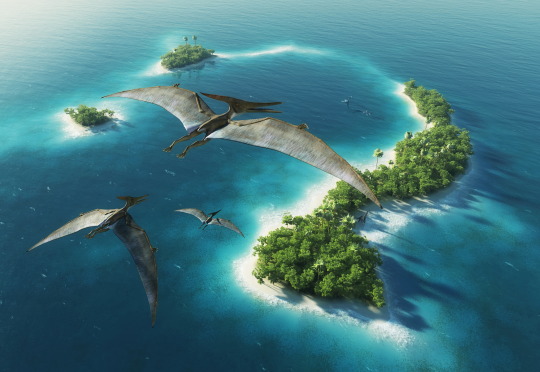
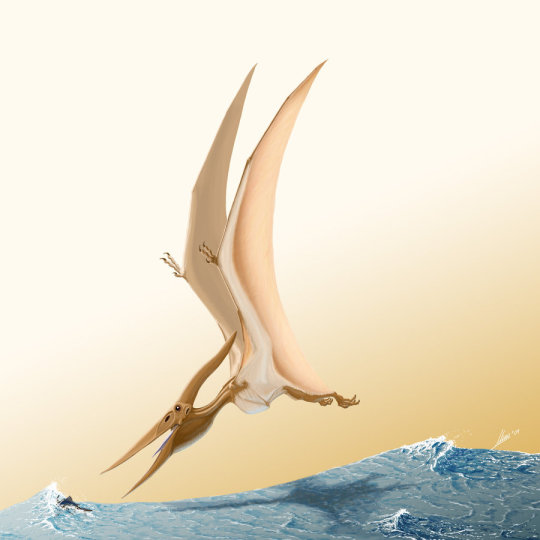
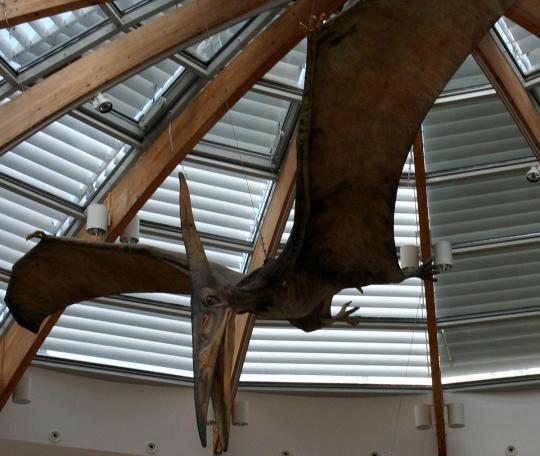
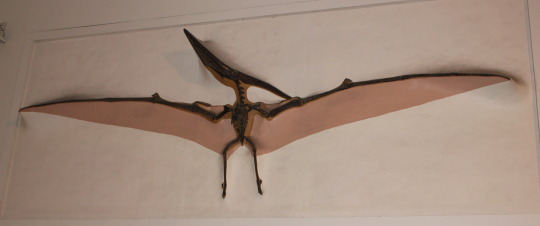
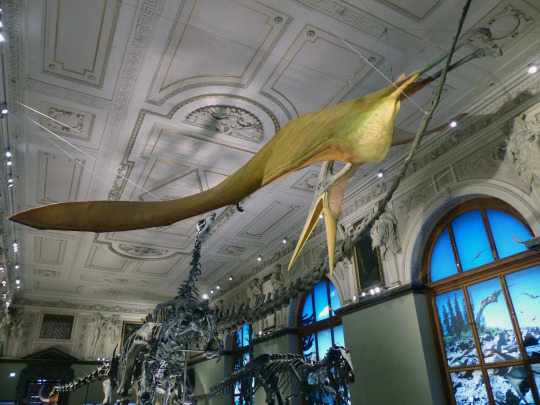
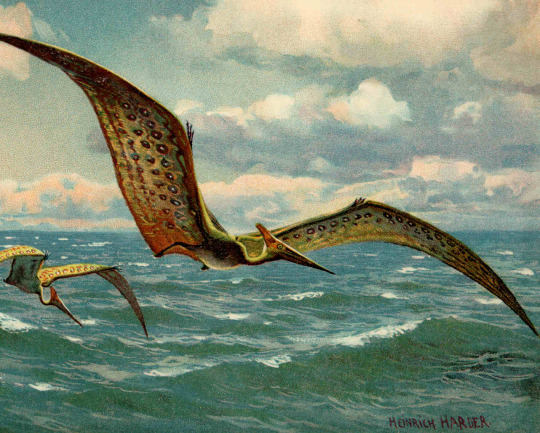

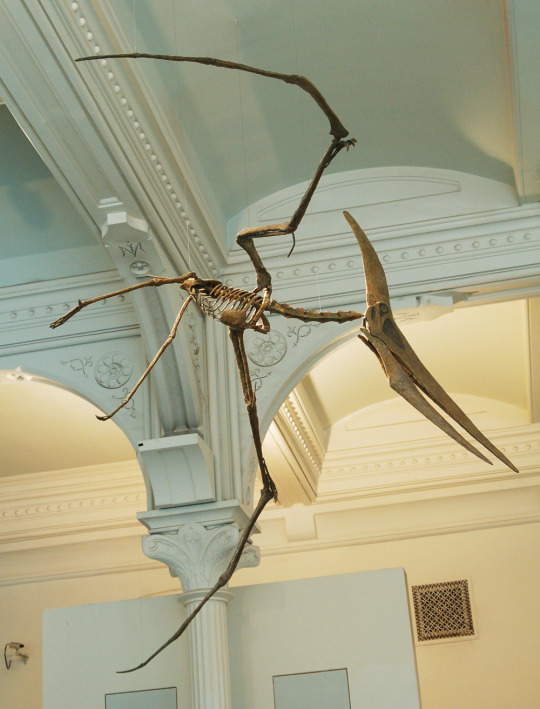

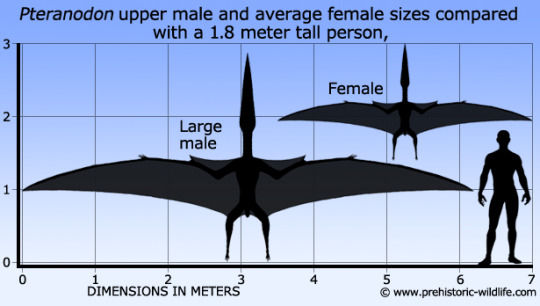
Pteranodon
(temporal range: 86-84.5 mio. years ago)
[text from the Wikipedia article, see also link above]
Pteranodon (/tɪˈrænədɒn/); from Ancient Greek πτερόν (pteron 'wing') and ἀνόδων (anodon 'toothless') is a genus of pterosaur that included some of the largest known flying reptiles, with P. longiceps having a wingspan of over 6 m (20 ft). They lived during the late Cretaceous geological period of North America in present-day Kansas, Nebraska, Wyoming, South Dakota and Alabama.[1] More fossil specimens of Pteranodon have been found than any other pterosaur, with about 1,200 specimens known to science, many of them well preserved with nearly complete skulls and articulated skeletons. It was an important part of the animal community in the Western Interior Seaway.[2]
Pteranodon was not a dinosaur. By definition, all dinosaurs belong to the group Dinosauria; Pteranodon belongs to the group Pterosauria. Nonetheless, Pteranodon is the most famous pterosaur, frequently featured in dinosaur media and strongly associated with dinosaurs by the general public.[3] While not dinosaurs, pterosaurs such as Pteranodon form a clade closely related to dinosaurs as both fall within the clade Avemetatarsalia.
4 notes
·
View notes
Text
Megapnosaurus

Etymology: Big Dead Lizard
Length: 3 meters ( 3 m )
Height: 80 centimeters ( 80 cm )
Weight: 32 kilograms ( 32 kg )
Diet: Carnivore
Temporal range: Early Jurassic, Mesozoic Era ( 199 million years ago - 188 million years ago )
Place: Africa ( Zimbabwe · South Africa )
Classification: Life, Animalia, Chordata, Vertebrata, Gnathostomata, Tetrapoda, Amniota, Sauropsida, Reptilia, Diapsida, Neodiapsida, Sauria, Archosauromorpha, Archosauriformes, Archosauria, Avemetatarsalia, Ornithodira, Dinosauromorpha, Dinosauriformes, Dracohors, Dinosauria, Saurischia, Theropoda, Neotheropoda, Coelophysoidea, Coelophysidae, Coelophysinae
0 notes
Note
Innacurate feets aside I am so in awe of his depiction of Geosternbergia. Yes pterosaurs are technically "flying reptiles" but it is often overlooked in popular media is how unreptilian they are. Well-muscled, endothermic bodies with airsacks and covered with a soft, insulating integument these guys are so derived it is hard to imagine being less like a reptile. Pterosaurs really were something unique and deserve to be thought of that way.
Yeah pterosaurs are basically the whales of Avemetatarsalia, by which I mean they were really pushing what they could do with Ornithodirian anatomy to the point that there isn’t really anything quite like like them. And it’s really a shame that a group of animals so bizarre that they were initially mistaken for flying mammal relatives doesn’t get any love appreciating how weird they truly are.
And while I am happy that birds took over and also pushed ornithodirian anatomy to the extreme, I am sad that pterosaurs are gone and that so much about them is lost to time.
#ask#questions#the-nerd-beast#pterosaurs#Avemetatarsalia#biology#they also make for some sick ass creature design inspiration
4 notes
·
View notes
Video
youtube
A newly described proto-dino-pterosaur provides new insights into the evolution of both dinosaurs and pterosaurs.
#kongonaphon#theropod#dinosauromorph#pterosauromorph#ornithodira#avemetatarsalia#insectivore#new discovery#scicomm#science education#earth science#life science#geology#biology#paleontology#fossils#science#histology#lines of arrested growth#lagerpetidae#transitional species#transitional fossil#jurassic park#jurassic world
24 notes
·
View notes
Text
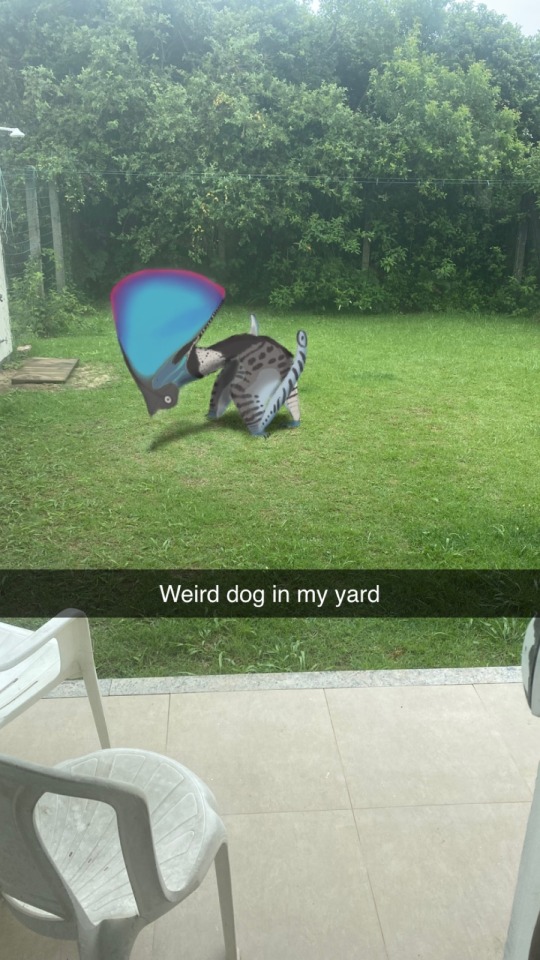
#weird#there is a dog#weird dog#strange#why is it blue#???#waiting for the tags to be long enough so we don’t see this but#->#Tupandactylus#Tupandactylus imperator#pterosaur#paleontology#ornithodira#avemetatarsalia#tapejarid
839 notes
·
View notes
Text
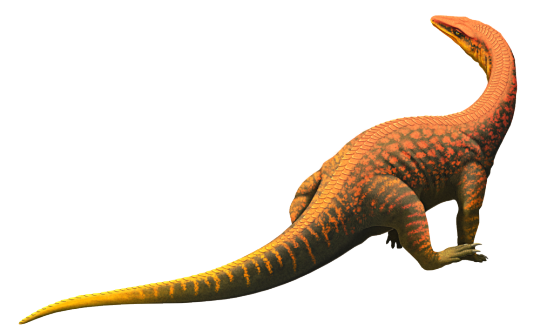
Mambachiton fiandohana lived during the mid-Triassic, about 237 million years ago, in what is now Madagascar – which at the time wasn't yet an island, still being connected to both east Africa and India as part of southern Pangaea.
It represents the earliest known branch of the avemetatarsalians, or "bird-line archosaurs", a major group of the archosaur reptiles that also includes pterosaurs and dinosaurs/birds.
It's only known from a few fragments but it was probably around 2m long (~6'6"), and would have been a carnivorous lizard-like animal with a long neck and semi-erect quadrupedal limb posture.
Unexpectedly for a bird-line archosaur it also had a staggered double row of bony osteoderms along its back, suggesting that the very earliest avemetatarsalians had some crocodilian-like armor. This seem to have very quickly been lost, though – there's no sign of osteoderms in the next branches to split off after Mambachiton, the aphanosaurs and pterosauromorphs – and although they occur again later in one dinosauriform and various non-avian dinosaurs, this appears to be multiple cases of independent re-evolution rather than retaining the original ancestral trait.
—
NixIllustration.com | Tumblr | Patreon
#science illustration#paleontology#paleoart#palaeoblr#mambachiton#avemetatarsalia#archosaur#reptile#art#there's some sparse fuzz if you look closely
306 notes
·
View notes
Note
.... Pan-Aves?

29 notes
·
View notes
Text
Mambachiton fiandohana

A young adult Mambachiton cannibalizes an egg stolen from the nest of another member of its own species. Hopefully, the egg's mother, who is likely a much larger and experienced individual, doesn't get too angry.
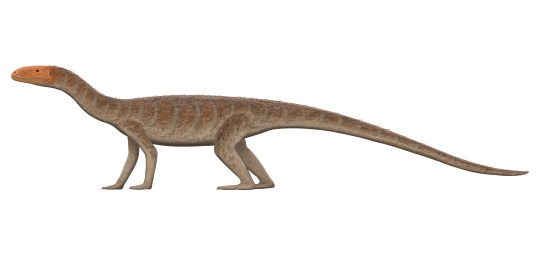
This recently described Triassic oddity, a descendent of the most basal known branch of avemetatarsalia (bird-line archosaurs) is, as the name implies, a close (ish) relative of birds! Mambachiton is only really known from just a single specimen of preserved postcranial material. However, among these remains, several osteoderms were found which may suggest that this creature, alongside all other avemetatarsalians, were likely ancestrally armored, which is quite strange when you remember that this is the lineage birds are descendants of. Overall, these elements made this animal quite the challenge to reconstruct, however I think I did pretty decent job here with this bulky aphanosaur-like form. (plus a bit of speculative fuzz!)
27 notes
·
View notes
Text
Episode 294: New Triassic dinosaur/pterosaur
I Know Dino Podcast Episode 294: New Triassic ornithodiran Kongonaphon, the "tiny bug slayer." It's from Madagascar and fills in some gaps in early #dinosaur and/or #pterosaur evolution.
Episode 294 is all about Albertaceratops, a relative of Styracosaurus (centrosaurine) that looks more like a Triceratops (chasmosaurine).
Big thanks to all our patrons! Your support means so much to us and keeps us going! If you’re a dinosaur enthusiast, join our growing community on Patreon at https://www.patreon.com/iknowdino.
You can listen to our free podcast, with all our episodes, on
View On WordPress
#Albertaceratops#amniote#Archosauria#Avemetatarsalia#Centrosaur#ceratopsian#chasmosaur#chris pratt#cladistics#Dimetrodon#dinosaur#dinosaur of the day#dinosauria#dinosauromorph#dinosaurs#Dominion#drive-in#Field#frill#fuzz#Gnathostomata#horns#i know dino#jurassic world#kely#Kongonaphon#Lagerpetid#Liverpool#Madagascar#Megalodon
2 notes
·
View notes